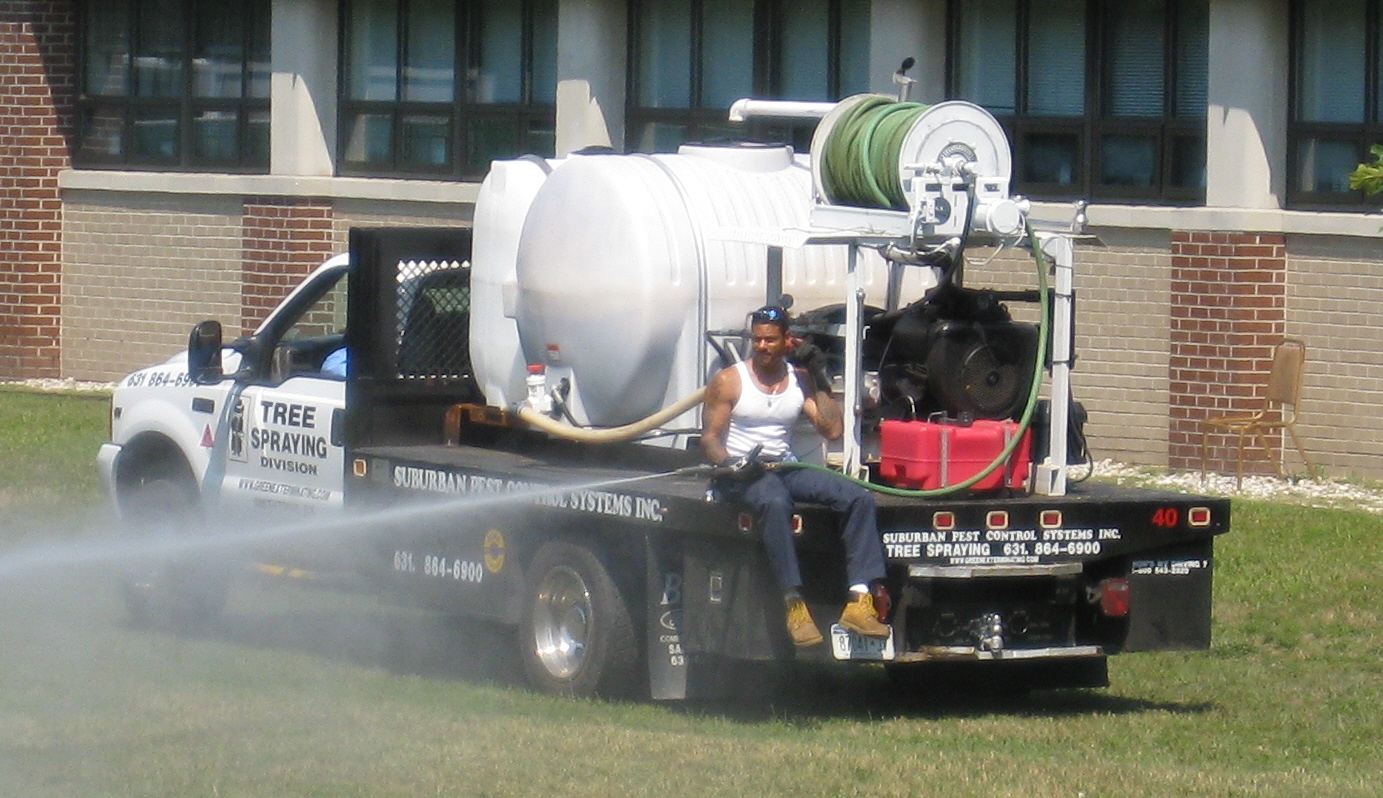When I thought to profile a national environmental professional, there’s very few people who put the “National” in National Environmental Professional more so than Matt and Joe Trujillo. Based out of Tooele, UT, the brothers are the heart and soul of Intermountain Technical Solutions, Inc., one of the premier environmental, health, and safety training companies in the country. They’ve trained over 120,000 students in 30 different subject areas in all 50 states, Canada, and Mexico. National, indeed! I’ve know them as long as I’ve been in the field and am continually impressed with their national influence, all while being based out of a small town in Utah. It was a pleasure, but not easy, to track them down from their busy travel schedules and talk to them about their careers as environmental professionals.
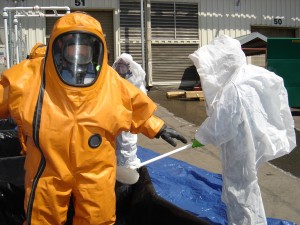
A typical day for Matt and Joe Trujillo.
TNEP: Tell me how you you got into the field? What drew you to the field?
Matt: I loved Science throughout school and initially wanted to look into the medical profession. As I entered college at the University of Utah in 1983, I found out that a new degree was being offered through the college of health called “Community Health/Environmental emphasis” It sounded interesting, combining the science and public health/medical into one degree.
Joe: When I was still in high school I had an interest in the physical sciences – chemistry, biology, and toxicology. When I enrolled in the University of Utah, my inclinaion was to pursue some kind of degree in these sciences. As an outdoor enthusiast, I really also enjoyed my time in the mountains fishing and saw some big changes at the time – some of the first consumption advisories for the fish we caught and water we drank. I though this was a wonderful marriage of the two things I enjoyed. I thought, I’m gonna make a career of this.
TNEP: Was there a moment, person, or a project when you realize this was good, interesting work?
Matt: Yes, during the early 80’s the county that I lived in became a major player in the waste management business. The military was discussing building the first ever chemical munitions incinerator (nerve agent and blister agent). One of the largest Hazardous Waste Landfills was operating already. A hazardous waste incinerator was being built and a second one was in the planning phases. In addition a low level radioactive repository was also being permitted. I was concerned that these facilities needed much regulatory oversight, so I sought to work for the State EPA and local health department. In 1987 when I graduated from the University of Utah, I began my career with the Tooele County Health Department and State EPA (later called DEQ) as an environmental scientist and regulatory auditor. I loved the challenge and the steep learning curve. In 1990 I went to go work for the hazardous waste landfill called USPCI as the Training Manager over compliance and safety training. I trained over 3,000 employees over a 3 year period. I started looking for 3rd party help to assist me in the training programs and I struggled finding anyone that could help me with the various topics (such as HAZWOPER, confined space entry and rescue, fall protection, mobile crane and forklift certification, etc.) I needed to provide to our staff. I actually asked my brother Joe to come out to the plant and help me teach some classes, which he did. It was then that we realized that so many businesses did not have the expertise to teach their employees these very important topics and that we should start a training company to help fill this important need.
Joe: When I was a student at University of Utah and I had a professor named Faye Resnik, as well as another, Herman Hooten, who were the first people who influenced me to look at the environmental responsibilities we all have, and to look at what kind of commitment it takes by a community and nation. The class wasn’t even called Environmental Sciences at that time. It was called Earth Sciences or some weird thing. It was my first opporutnity to see there’s some things we can do to make things better. As I work around the country teaching environmental regulations courses, I’ll have students, who I didn’t think were getting the message, who will call me later and say, “Hey, I really want more information on this. Is there someplace else you’d recommned” Man, I tell you what, each of those is a reaffirmation of what we’re diong is important and having an impact.
TNEP: What is a positive change you’ve seen in the field and/or lifestyle since you started?
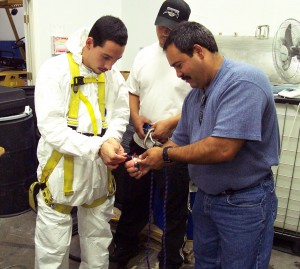
Matt Trujillo teaching.
Matt: When I started in this field, so many people were uninformed about hazardous chemicals and how to use them safely and manage their waste properly. Over the last 20 years, my brother and I and the rest of our staff have taught courses in all 50 states and Canada and Mexico, We have worked with all types of industries and the government. We have trained over 120,000 in over 30 different subject areas. We have also trained and certified over 500 industrial hazmat teams across the county. I still cannot believe how such a small company like ours has spanned the entire country. It is so cool to have a student tell us that what we taught them made a difference in their lives and that their knowledge and skills can now be used to help others.
Joe: When I came out of college, the vast majority of waste coming from Superfund sites was being managed by incineration or solidification and landfill. In essence, what we had at at that time was, “burn or bury.” What’s changed the most are improvement in methodologies and modifying processes to use less harmful chemicals. There pre-detoxificiation now. We’ll take a chemical and do a neutralization instead of it just going to a landfill. I’m happy to see the evolution of the methods of disposal that we deal with our waste.
TNEP: What’s still missing from the field?
Matt: As has been evident in recent tragedies across the county, Most chemical plants are still not providing adequate training for their employees and most public sector emergency responders such as firemen, policemen, paramedics are receiving very minimal if any training on how to deal with hazmat emergencies. In addition a trend across the country is to provide training through computer based learning and on line with very little or no actual hands on instruction and no ability to discuss key concepts with a professional trainers.
Joe: I see less recycling taking place. It seems to me that as I travel the nation that some communities do a great job and embrace it. Many communities, it’s worse than it’s been 10 years ago. We’ve failed in maintaining succession in some of those things that we bragged about in the past. The other thing, this is more my hunting side, the last 5 years I’ve seen more and more consumption advisories posted for waterfowl species and fish species. That’s a sign of how much more work we have to go. The mercury content is too high. It’s a sad commentary. We’ve still got some work. The good news is that I’m up for the task. I stand on ever soapbox I’m offered and tell people, “Here’s what we’ve got to do?”
TNEP: Tell me about your interaction with the people you impact who aren’t environmental professionals. Is it positive, unusual, tough to overcome, fun, enlightening, etc?
Matt: Most of the people we train are not environmental professionals. Many still have “old school” mentalities that the EPA, OSHA etc are not necessary and that protecting the environment is silly and a waste of time. These are our special challenges. It is always refreshing however to change their mindset and get them to buy into the importance of what we are teaching. Also many past students that we have taught, have decided to make their careers as hazmat/environmental professionals such as a young man that was a pharmacist major that took one of our classes as a college student and decided to change his major into Safety/Environmental specialist. Years later he became the EHS manager of a large industrial plant and called us up and said, hey remember me, I was in your class 8 years ago. I want the very best training for my new plant and I want ITS to deliver it!! That was cool!
TNEP: How has a career as an environmental professional impacted your lifestyle, family, etc?
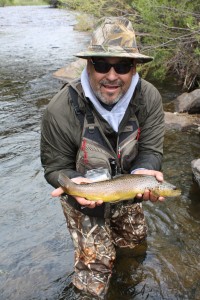
Matt hardly working.
Matt: My career has taken me on the road a lot. My family and especially my wife has had to be very patient with me and the time I am away from home. My wife and 3 sons know however how passionate I am about what I do and how important it is for me and they have supported me for over 25 years. Weeks after 9/11, I took my son Nick to New york with me where I was providing RCRA hazardous waste management training for the Army Reserves. I took Nick to ground zero and had him sit in on all the training I provided that week. 10 years later Nick had completed a BS degree and a Masters degree and started working for our company as our 3rd full time trainer. He said that my passion for this work rubbed off on him. My chest swells with pride when a client of ours calls me after Nick has taught for them and says to me, “He is just like you and your brother. He is an awesome communicator and knows his stuff, and he has the same passion as you do!”
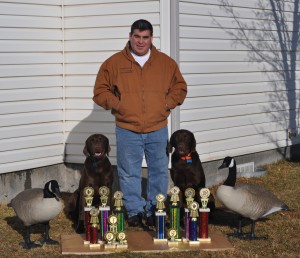
Joe and his champion dogs.
Joe: It was Matt’s idea to start Intermountain Technical Solutions. He said, “I think we can keep doing what we’re doing. What we enjoy most about environmental responsibility. But let’s do it for ourselves and let’s take this information out as subject area experts and work in industry. To help these folks to train their employees and properly manage their chemicals has some real benefit, not on environmentally, but from a health and safety perspective. I’ve worked in everyone of our great United States, Canada and Mexico. It’s been awesome and I have not regretted a single minute. It’s been a lifelong dream to not only work in the environmetnal arena but work with my brother.
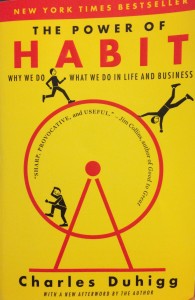 One story in The Power of Habit: Why We Do What We Do in Life and Business, by Charles Duhigg, opened my eyes to how much of my work over the past 15 years has been trying to break a habit loop.That is the story of former Alcoa CEO, Paul O’Neill, who improved the entire company focusing only on the keystone habit of safe work practices. I’ve been doing something similar in my job without understanding the science behind it.
One story in The Power of Habit: Why We Do What We Do in Life and Business, by Charles Duhigg, opened my eyes to how much of my work over the past 15 years has been trying to break a habit loop.That is the story of former Alcoa CEO, Paul O’Neill, who improved the entire company focusing only on the keystone habit of safe work practices. I’ve been doing something similar in my job without understanding the science behind it.



